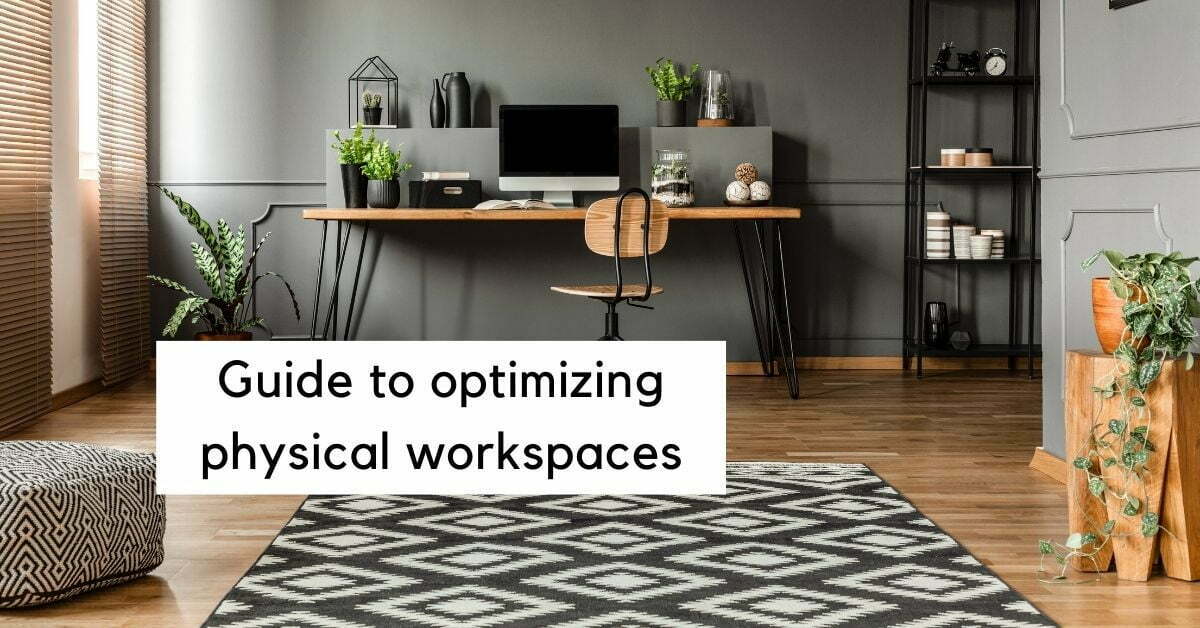The ultimate guide to optimizing physical workspaces
Did you know that the average person spends approximately 90,000 hours at work over their lifetime? That’s a significant amount of time spent in the confines of a physical workspace. So why not make it the best space possible?
In this ultimate guide to optimizing physical workspaces, we will explore practical strategies and techniques to transform your workspace into a powerful tool for success.
Benefits of a well-optimized workspace
You spend a third of your day in your workspace, so why not make the most of it? The setup of your workspace has a huge impact on your productivity, health, and happiness.
1. Efficient workflow
When your workspace is optimized, it not only helps you to work faster but also ensures that you work smarter by minimizing time wasted on unnecessary movements or searching for items, enabling you to work more efficiently and complete tasks on time.
2. Enhanced concentration and focus
With an optimized workspace, you can maintain better mental clarity and stay engaged in your work by eliminating visual and auditory distractions, such as clutter, noise, or interruptions. This can lead to improved performance and higher-quality output while working on tasks that require your full attention.
3. Increased productivity
When your workspace is set up properly, you can get into the zone and power through your tasks efficiently. A well-optimized workspace can significantly boost productivity. When everything is easily accessible and arranged logically, it minimizes time wasted searching for items or information.
4. Improved physical health
Having an optimized workspace can do wonders for your physical health and well-being. When your workspace is set up properly, it reduces strain on your body and encourages better habits.
You’ll experience less back, neck, and eye strain when your desk, chair, computer screen, and other equipment are at the proper heights and positions for your body.
5. Improved mental health
A clean, organized, and aesthetically pleasing workspace can create a positive and calming atmosphere, reducing stress levels and promoting a sense of well-being. Additionally, personalizing your workspace with items that bring you joy, such as plants, pictures, or artwork, can enhance your mood and overall happiness.
How to optimize your physical workspaces
Now that you understand the importance of a well-optimized workspace, let’s explore some practical ways to achieve it. Below is a list of strategies and techniques to help you create a workspace that is tailored to your needs, enhances your well-being, and boosts productivity.
1. Assess your workspace needs
Assessing your workspace needs is crucial for creating a productive and comfortable environment that will make you feel excited to tackle each day.
Identify key tasks and activities for efficient workspace optimization
To optimize your physical workspace, start by identifying key tasks and activities that you regularly perform. This will help determine the necessary equipment and furniture that will support your work efficiently. Consider the type of work you do and the tools you need to complete it effectively.
Consider space and layout for a seamless workflow
Next, think about space and layout considerations. Evaluate how much space you require for each task and what kind of layout would promote seamless workflow. Consider factors such as proximity to essential resources, ease of movement, and access to natural light.
Analyze furniture needs for optimal comfort
Analyze whether your current furniture meets your needs or if any adjustments are required. Ergonomic chairs and adjustable desks can significantly improve comfort and reduce strain on your body.
By assessing these aspects thoroughly, you can create a workspace tailored specifically to your requirements, enhancing productivity, efficiency, and overall satisfaction in completing tasks.
2. Maximize natural lighting
Maximizing natural lighting in your workspace can create an enjoyable and energizing environment. Not only does it provide numerous benefits for your overall well-being, but it also enhances productivity and focus.
Assessing Your Windows for Optimal Natural Light
To optimize the amount of natural light in your workspace, start by assessing your windows. Make sure they’re clean and unobstructed to allow maximum sunlight to enter the room. Consider using sheer curtains or blinds that can be easily adjusted to control the amount of light coming in.
Amplifying Natural Light with Mirrors
Another effective way to maximize natural lighting is by strategically placing mirrors in your workspace. Mirrors can help reflect and amplify the natural light, making the room feel brighter and more spacious. Experiment with different positions and angles to find the best placement for maximum effect.
3. Decluttering and organizing your space
To transform your workspace into a clutter-free oasis, channel your inner Marie Kondo and let go of the unnecessary, allowing your creativity to soar in a space unburdened by excess. Embrace minimalist design principles that prioritize simplicity and functionality.
Let go of the unnecessary things
Start by decluttering your space, removing any items that don’t serve a practical purpose or bring you joy.
Use storage
Utilize effective storage solutions to keep everything organized. Shelves, drawers, and filing cabinets are essential tools for keeping your workspace tidy. Assign specific places for each item so you can easily find what you need when you need it.
Create harmony with feng shui principles
Consider implementing Feng Shui principles to create harmony in your workspace. Position your desk in a power position facing the door, allowing you to see who enters the room while working. Use plants and natural elements to bring life and positive energy into the space.
Here are some quick decluttering tips: regularly assess what items are necessary and remove anything that no longer serves a purpose; tackle one area at a time rather than overwhelming yourself with the entire workspace; designate an inbox tray for incoming paperwork; develop daily habits of tidying up before leaving work.
By following these strategies, you’ll create an optimized physical workspace that promotes productivity and success while minimizing distractions.
4. Personalize your workspace for inspiration
Spruce up your workspace with personal touches that reflect your unique style and inspire creativity. Adding personal elements to your workspace can make it feel more inviting and motivating.
Use uplifting words for daily encouragement
Consider using motivational quotes that align with your goals and values. Place them where you can easily see them throughout the day, whether it’s on a sticky note, a whiteboard, or even framed on the wall. These uplifting words can provide daily encouragement and keep you focused on achieving success.
Choose colors to promote focus and well-being
Color psychology is another important aspect when personalizing your workspace. Choose colors that promote focus and well-being, such as blues for calmness, greens for productivity, or yellows for optimism.
Bring nature indoors
Don’t forget about the role of biophilic design in workspaces. Incorporate plants into your decor to bring nature indoors. Studies have shown that having plants in the office can reduce stress levels and increase creativity.
By personalizing your workspace with these elements, you create an environment that promotes inspiration and creative thinking.
5. Ergonomics and comfort
When personalizing your workspace, it’s important to prioritize ergonomics and comfort for optimal productivity and well-being.
Did you know that studies have shown that using ergonomic accessories like footrests and wrist rests can reduce the risk of musculoskeletal disorders by up to 71%?
Invest in ergonomic furniture
To create an ergonomic and comfortable workspace, consider investing in ergonomic furniture such as adjustable chairs and desks. These allow you to customize the height and angle of your seating options, ensuring proper alignment of your body while working.
Standing desks for good posture
Standing desks are another excellent option for promoting good posture and reducing sedentary behavior. They provide the flexibility to alternate between sitting and standing throughout the day, preventing prolonged periods of sitting that can lead to back pain or other health issues.
Comfort accessories
In addition to ergonomic furniture, comfort accessories play a crucial role in enhancing your work experience. Consider using a footrest if your feet don’t comfortably touch the ground when seated. This helps alleviate pressure on your lower back and promotes better blood circulation. Wrist rests can also provide support during long hours of typing, reducing strain on your wrists.
6. Maintaining a healthy workspace
To maintain a healthy workspace, imagine a clean and organized environment that promotes productivity and supports your well-being. Creating a clean workspace is essential for optimal performance. Regular cleaning and maintenance should be prioritized to ensure a clutter-free area.
Regular cleaning and maintenance
Dusting surfaces, vacuuming carpets, and wiping down equipment will not only keep your workspace tidy but also reduce the presence of allergens.
Reduce noise pollution
Noise pollution can be detrimental to concentration and focus. To reduce noise levels, consider using sound-absorbing materials like acoustic panels or rugs.
Improve air quality
Improving air quality is crucial for maintaining a healthy workspace. Ensure proper ventilation by opening windows when possible or using fans to circulate fresh air. Consider investing in air purifiers that filter out airborne particles like dust and allergens.
7. Creating a quiet and distraction-free zone
Creating a quiet and distraction-free zone is important in workspaces because it allows individuals to focus better on their tasks, leading to increased productivity, improved quality of work, and reduced stress levels.
Invest in noise-canceling headphones
To maximize your focus and productivity, create a quiet and distraction-free zone in your workspace. Noise-canceling headphones are an excellent investment to block out background noise and create a serene environment. Look for high-quality ones that provide superior sound isolation.
Soundproofing
Additionally, consider implementing soundproofing solutions to further reduce external disturbances. Acoustic panels or curtains can be strategically placed to absorb unwanted sounds and create a more peaceful atmosphere.
Optimize your work area layout
Another aspect to consider is the layout of your work area. Position your desk away from high-traffic areas or sources of noise such as doors or windows facing busy streets. This will help minimize distractions and enable you to concentrate better on your tasks.
Use soothing background sounds
Incorporating white noise machines can be highly effective in drowning out disruptive sounds by emitting soothing background noises like ocean waves or rainfall. These devices are particularly useful when working in open office spaces where conversations or phone calls can easily distract you.
8. Implementing break and relaxation areas
Create a designated area in your workspace where you can take breaks and relax, providing yourself with much-needed rejuvenation amidst the demands of your work.
Create a calming atmosphere
Creating a calming atmosphere is essential for promoting relaxation and reducing stress levels. Incorporate nature elements into this space by adding plants or a small water feature to bring a sense of tranquility.
Mindfulness area
In addition to physical comfort, it’s important to promote mindfulness practices during your break. Consider incorporating meditation cushions or yoga mats for those who wish to engage in mindfulness exercises during their breaks. Provide access to wellness resources like books on mindfulness, stress management, or guided meditation apps.
By dedicating this space solely for relaxation purposes, you can train your mind and body to associate it with rest and rejuvenation. Make sure the area is free from distractions like noise or clutter that may hinder your ability to truly unwind.
Remember, taking regular breaks throughout the day not only improves productivity but also enhances overall well-being. So prioritize creating an inviting break and relaxation area within your physical workspace today!
How to promote movement and activity in your workspace
Now that you understand how to optimize your physical workspaces, let’s delve into the next crucial aspect: promoting movement and activity.
To truly optimize your physical workspace, it’s essential to incorporate strategies that encourage regular movement throughout the day. Active sitting, standing desks, exercise breaks, movement trackers, and ergonomic furniture all play a vital role in achieving this goal.
Active sitting
Consider using an active sitting chair or balance ball chair that engages your core muscles while you work. This not only promotes better posture but also encourages subtle movements that can help prevent stiffness.
Standing desks
Invest in a height-adjustable desk that allows you to alternate between sitting and standing positions. Standing for short periods can reduce sedentary behavior and improve circulation.
Exercise breaks
Set aside designated times during your workday for quick exercise breaks. Simple stretches or a brisk walk around the office can boost energy levels and enhance productivity.
Movement trackers
Utilize wearable devices or smartphone apps to track your daily activity levels. These tools provide valuable insights into how much time you spend being sedentary versus active, motivating you to move more frequently.
Ergonomic furniture
Opt for ergonomic chairs, keyboards, and mouse pads that promote natural body alignment and reduce strain on muscles.
By incorporating these strategies into your physical workspace, you’ll create an environment that actively encourages movement throughout the day, helping you stay energized and focused on achieving power-packed results.
How to effectively manage and prioritize workload in a physical workspace
Develop a routine to keep on top of new tasks and priorities as they come in each day or week. Check your to-do list and calendar regularly and schedule time for important work. Learn to say no when needed to avoid being overloaded. Take frequent breaks to recharge and renew your mental focus. Even taking short walking breaks can help.
To effectively manage your workload in a physical workspace, prioritize tasks based on urgency and importance. Utilize time management techniques like the Pomodoro Technique and efficient work habits to increase productivity and maintain control over your schedule.
How to keep physical workspaces clean and organized
Keeping your workspace clean and organized is key to staying productive and focused. A messy desk means a messy mind. Make it a habit to tidy up your space at the end of each day or week.
File away or throw out any loose papers. Put pens, pencils, and other supplies in drawer organizers or pencil cups. Group together items that are used together. For example, keep your keyboard, mouse, and mousepad in one area. Minimize clutter on your desk by using vertical space for storage, like wall racks, shelves, and cabinets.
Final thoughts
Overall, optimizing your physical workspace goes beyond just having an aesthetically pleasing environment. It involves creating a space that nurtures your productivity, well-being, and creative output on a holistic level. From maximizing natural light and decluttering to promoting ergonomic comfort and incorporating movement, every strategy helps transform your workspace into a temple dedicated to your success.
While the details may differ for each individual, the common goal remains the same – to build an environment that activates your mind, body, and spirit to do their best work. An optimized workspace allows you to nurture inspiration, eliminate distractions and maintain sustained focus as needed to accomplish your life’s goals.







